Project Management, Leadership and Skills: Planning and Control
VerifiedAdded on 2023/06/15
|17
|4716
|318
AI Summary
The report discusses the role of motivation, leadership, and communication in project management. It analyzes how effective communication and leadership skills can motivate employees to work towards organizational goals. The report also covers motivational theories such as Maslow Hierarchy of Needs and Theory Z to motivate employees to work in the project.
Contribute Materials
Your contribution can guide someone’s learning journey. Share your
documents today.
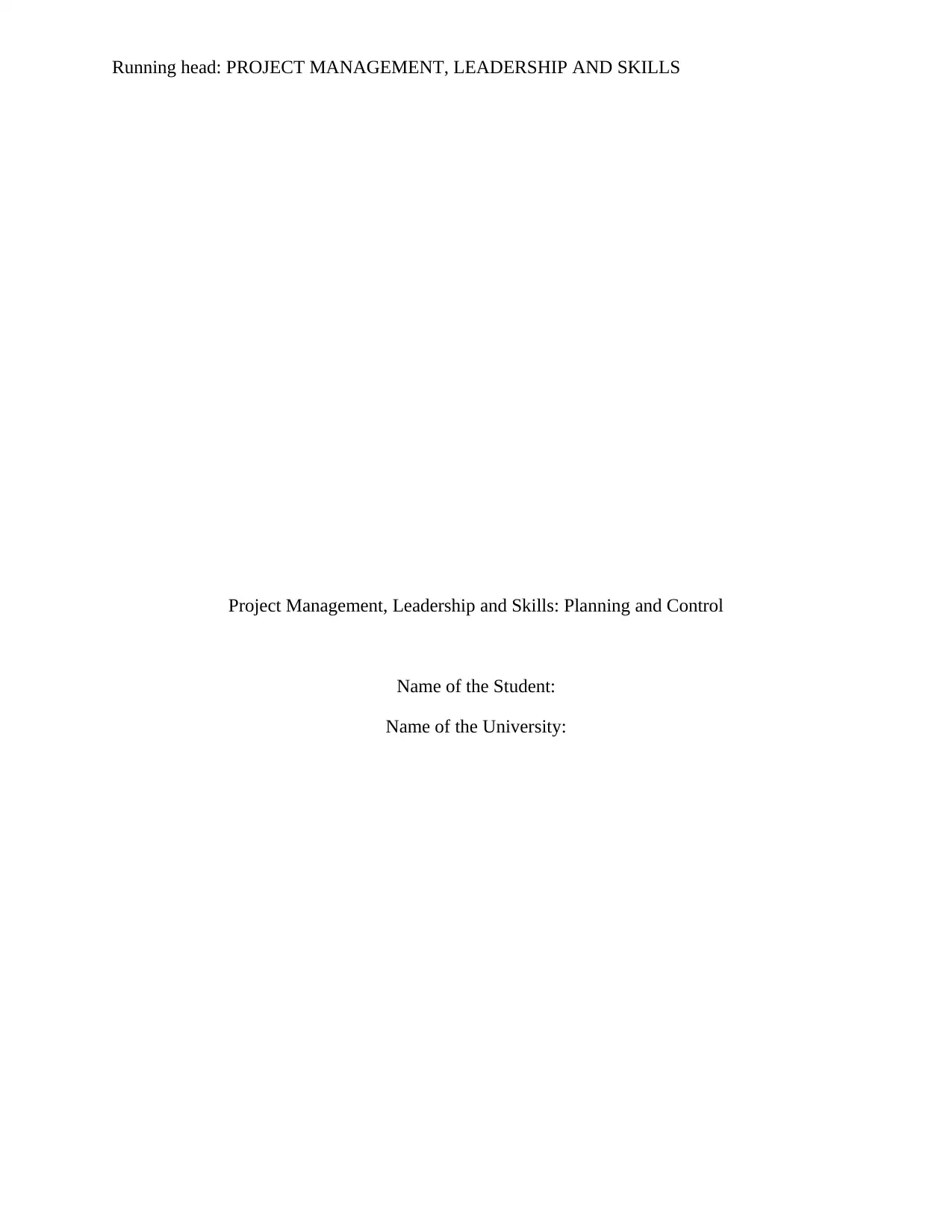
Running head: PROJECT MANAGEMENT, LEADERSHIP AND SKILLS
Project Management, Leadership and Skills: Planning and Control
Name of the Student:
Name of the University:
Project Management, Leadership and Skills: Planning and Control
Name of the Student:
Name of the University:
Secure Best Marks with AI Grader
Need help grading? Try our AI Grader for instant feedback on your assignments.
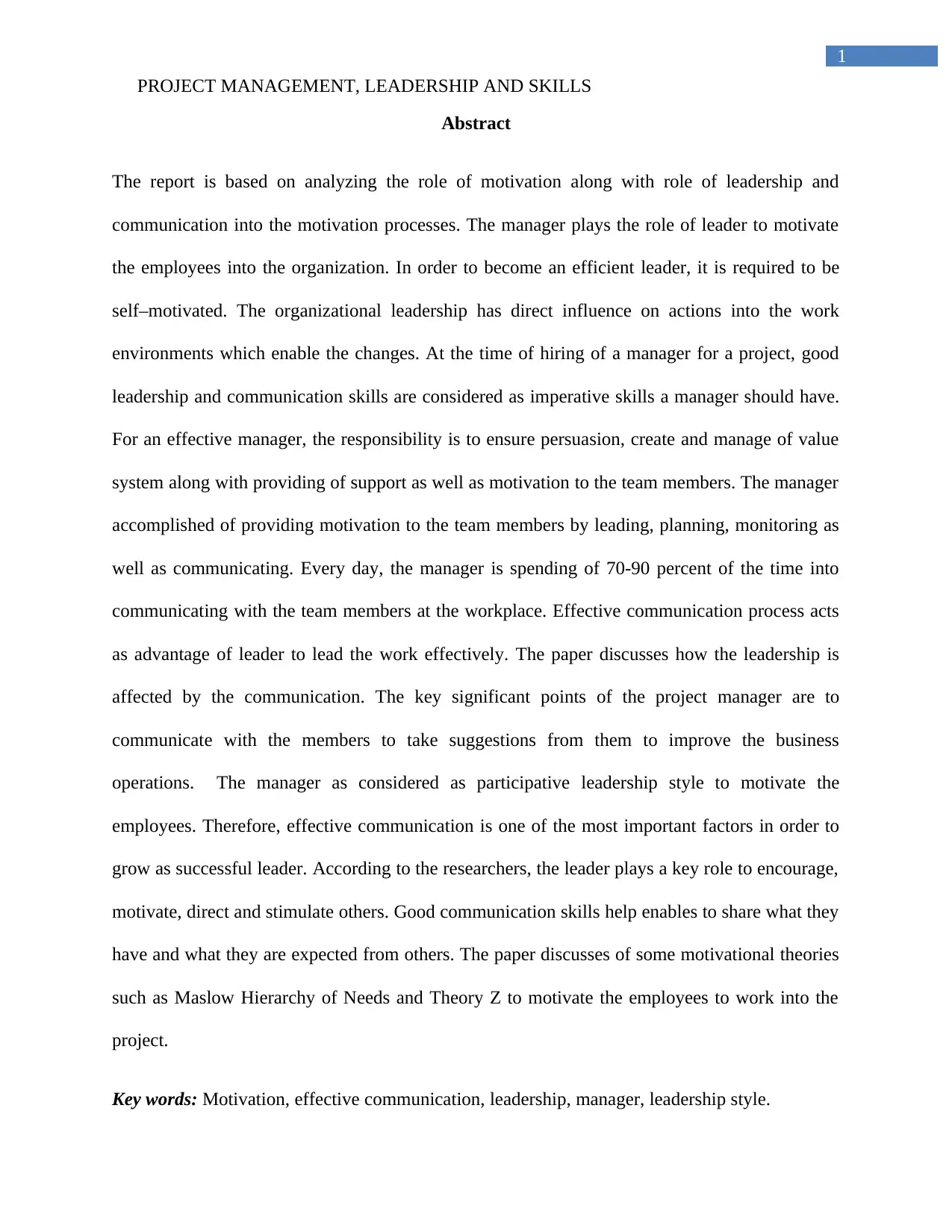
1
PROJECT MANAGEMENT, LEADERSHIP AND SKILLS
Abstract
The report is based on analyzing the role of motivation along with role of leadership and
communication into the motivation processes. The manager plays the role of leader to motivate
the employees into the organization. In order to become an efficient leader, it is required to be
self–motivated. The organizational leadership has direct influence on actions into the work
environments which enable the changes. At the time of hiring of a manager for a project, good
leadership and communication skills are considered as imperative skills a manager should have.
For an effective manager, the responsibility is to ensure persuasion, create and manage of value
system along with providing of support as well as motivation to the team members. The manager
accomplished of providing motivation to the team members by leading, planning, monitoring as
well as communicating. Every day, the manager is spending of 70-90 percent of the time into
communicating with the team members at the workplace. Effective communication process acts
as advantage of leader to lead the work effectively. The paper discusses how the leadership is
affected by the communication. The key significant points of the project manager are to
communicate with the members to take suggestions from them to improve the business
operations. The manager as considered as participative leadership style to motivate the
employees. Therefore, effective communication is one of the most important factors in order to
grow as successful leader. According to the researchers, the leader plays a key role to encourage,
motivate, direct and stimulate others. Good communication skills help enables to share what they
have and what they are expected from others. The paper discusses of some motivational theories
such as Maslow Hierarchy of Needs and Theory Z to motivate the employees to work into the
project.
Key words: Motivation, effective communication, leadership, manager, leadership style.
PROJECT MANAGEMENT, LEADERSHIP AND SKILLS
Abstract
The report is based on analyzing the role of motivation along with role of leadership and
communication into the motivation processes. The manager plays the role of leader to motivate
the employees into the organization. In order to become an efficient leader, it is required to be
self–motivated. The organizational leadership has direct influence on actions into the work
environments which enable the changes. At the time of hiring of a manager for a project, good
leadership and communication skills are considered as imperative skills a manager should have.
For an effective manager, the responsibility is to ensure persuasion, create and manage of value
system along with providing of support as well as motivation to the team members. The manager
accomplished of providing motivation to the team members by leading, planning, monitoring as
well as communicating. Every day, the manager is spending of 70-90 percent of the time into
communicating with the team members at the workplace. Effective communication process acts
as advantage of leader to lead the work effectively. The paper discusses how the leadership is
affected by the communication. The key significant points of the project manager are to
communicate with the members to take suggestions from them to improve the business
operations. The manager as considered as participative leadership style to motivate the
employees. Therefore, effective communication is one of the most important factors in order to
grow as successful leader. According to the researchers, the leader plays a key role to encourage,
motivate, direct and stimulate others. Good communication skills help enables to share what they
have and what they are expected from others. The paper discusses of some motivational theories
such as Maslow Hierarchy of Needs and Theory Z to motivate the employees to work into the
project.
Key words: Motivation, effective communication, leadership, manager, leadership style.
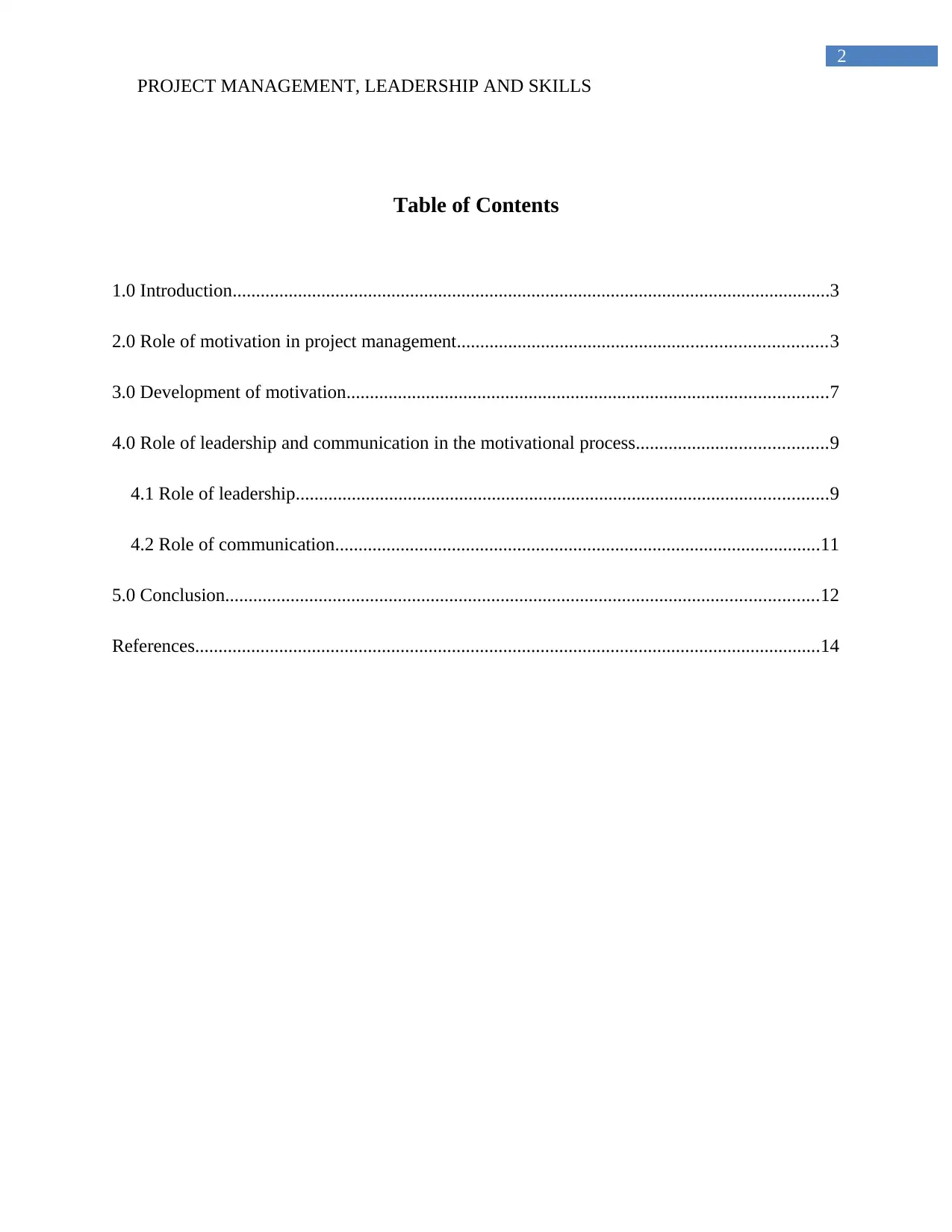
2
PROJECT MANAGEMENT, LEADERSHIP AND SKILLS
Table of Contents
1.0 Introduction................................................................................................................................3
2.0 Role of motivation in project management...............................................................................3
3.0 Development of motivation.......................................................................................................7
4.0 Role of leadership and communication in the motivational process.........................................9
4.1 Role of leadership..................................................................................................................9
4.2 Role of communication........................................................................................................11
5.0 Conclusion...............................................................................................................................12
References......................................................................................................................................14
PROJECT MANAGEMENT, LEADERSHIP AND SKILLS
Table of Contents
1.0 Introduction................................................................................................................................3
2.0 Role of motivation in project management...............................................................................3
3.0 Development of motivation.......................................................................................................7
4.0 Role of leadership and communication in the motivational process.........................................9
4.1 Role of leadership..................................................................................................................9
4.2 Role of communication........................................................................................................11
5.0 Conclusion...............................................................................................................................12
References......................................................................................................................................14
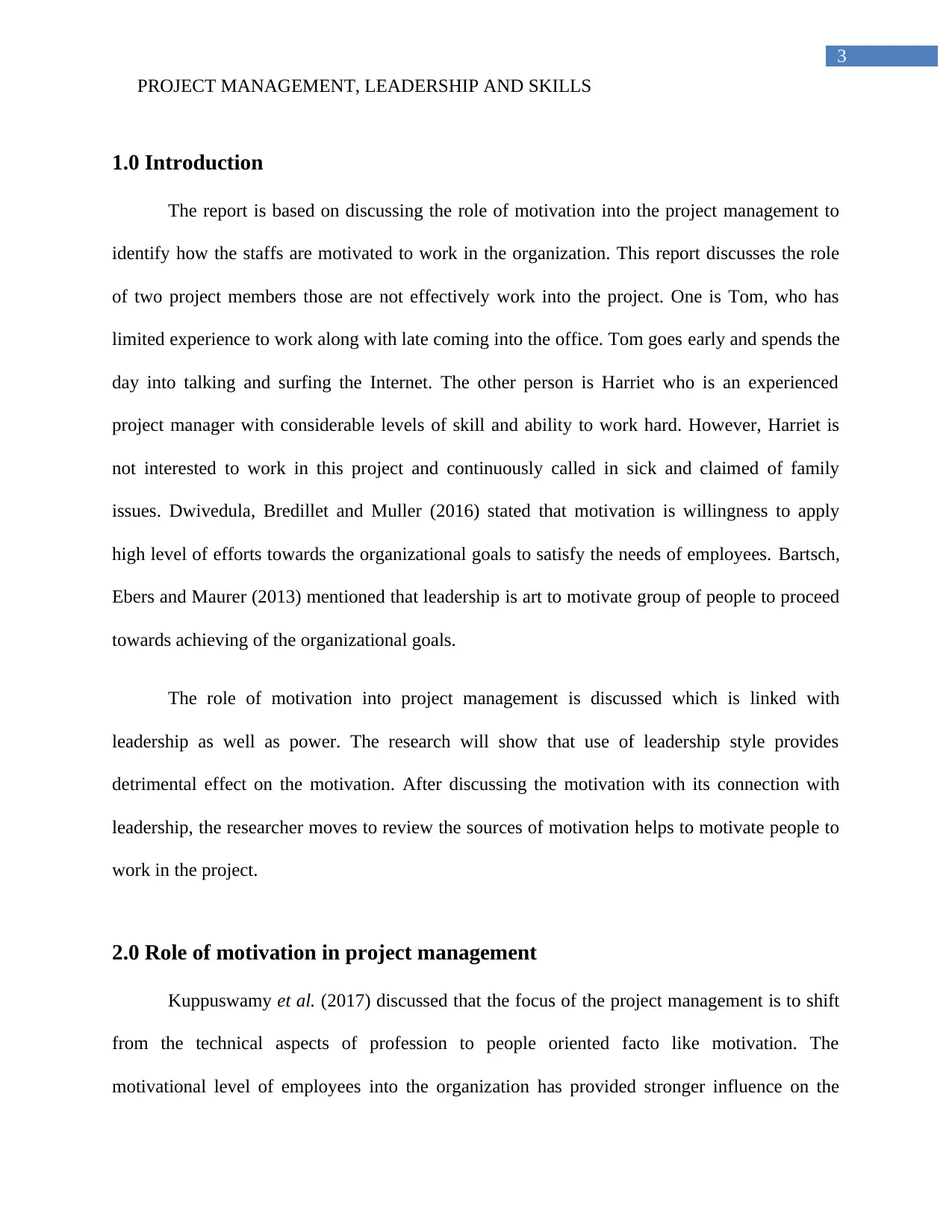
3
PROJECT MANAGEMENT, LEADERSHIP AND SKILLS
1.0 Introduction
The report is based on discussing the role of motivation into the project management to
identify how the staffs are motivated to work in the organization. This report discusses the role
of two project members those are not effectively work into the project. One is Tom, who has
limited experience to work along with late coming into the office. Tom goes early and spends the
day into talking and surfing the Internet. The other person is Harriet who is an experienced
project manager with considerable levels of skill and ability to work hard. However, Harriet is
not interested to work in this project and continuously called in sick and claimed of family
issues. Dwivedula, Bredillet and Muller (2016) stated that motivation is willingness to apply
high level of efforts towards the organizational goals to satisfy the needs of employees. Bartsch,
Ebers and Maurer (2013) mentioned that leadership is art to motivate group of people to proceed
towards achieving of the organizational goals.
The role of motivation into project management is discussed which is linked with
leadership as well as power. The research will show that use of leadership style provides
detrimental effect on the motivation. After discussing the motivation with its connection with
leadership, the researcher moves to review the sources of motivation helps to motivate people to
work in the project.
2.0 Role of motivation in project management
Kuppuswamy et al. (2017) discussed that the focus of the project management is to shift
from the technical aspects of profession to people oriented facto like motivation. The
motivational level of employees into the organization has provided stronger influence on the
PROJECT MANAGEMENT, LEADERSHIP AND SKILLS
1.0 Introduction
The report is based on discussing the role of motivation into the project management to
identify how the staffs are motivated to work in the organization. This report discusses the role
of two project members those are not effectively work into the project. One is Tom, who has
limited experience to work along with late coming into the office. Tom goes early and spends the
day into talking and surfing the Internet. The other person is Harriet who is an experienced
project manager with considerable levels of skill and ability to work hard. However, Harriet is
not interested to work in this project and continuously called in sick and claimed of family
issues. Dwivedula, Bredillet and Muller (2016) stated that motivation is willingness to apply
high level of efforts towards the organizational goals to satisfy the needs of employees. Bartsch,
Ebers and Maurer (2013) mentioned that leadership is art to motivate group of people to proceed
towards achieving of the organizational goals.
The role of motivation into project management is discussed which is linked with
leadership as well as power. The research will show that use of leadership style provides
detrimental effect on the motivation. After discussing the motivation with its connection with
leadership, the researcher moves to review the sources of motivation helps to motivate people to
work in the project.
2.0 Role of motivation in project management
Kuppuswamy et al. (2017) discussed that the focus of the project management is to shift
from the technical aspects of profession to people oriented facto like motivation. The
motivational level of employees into the organization has provided stronger influence on the
Secure Best Marks with AI Grader
Need help grading? Try our AI Grader for instant feedback on your assignments.
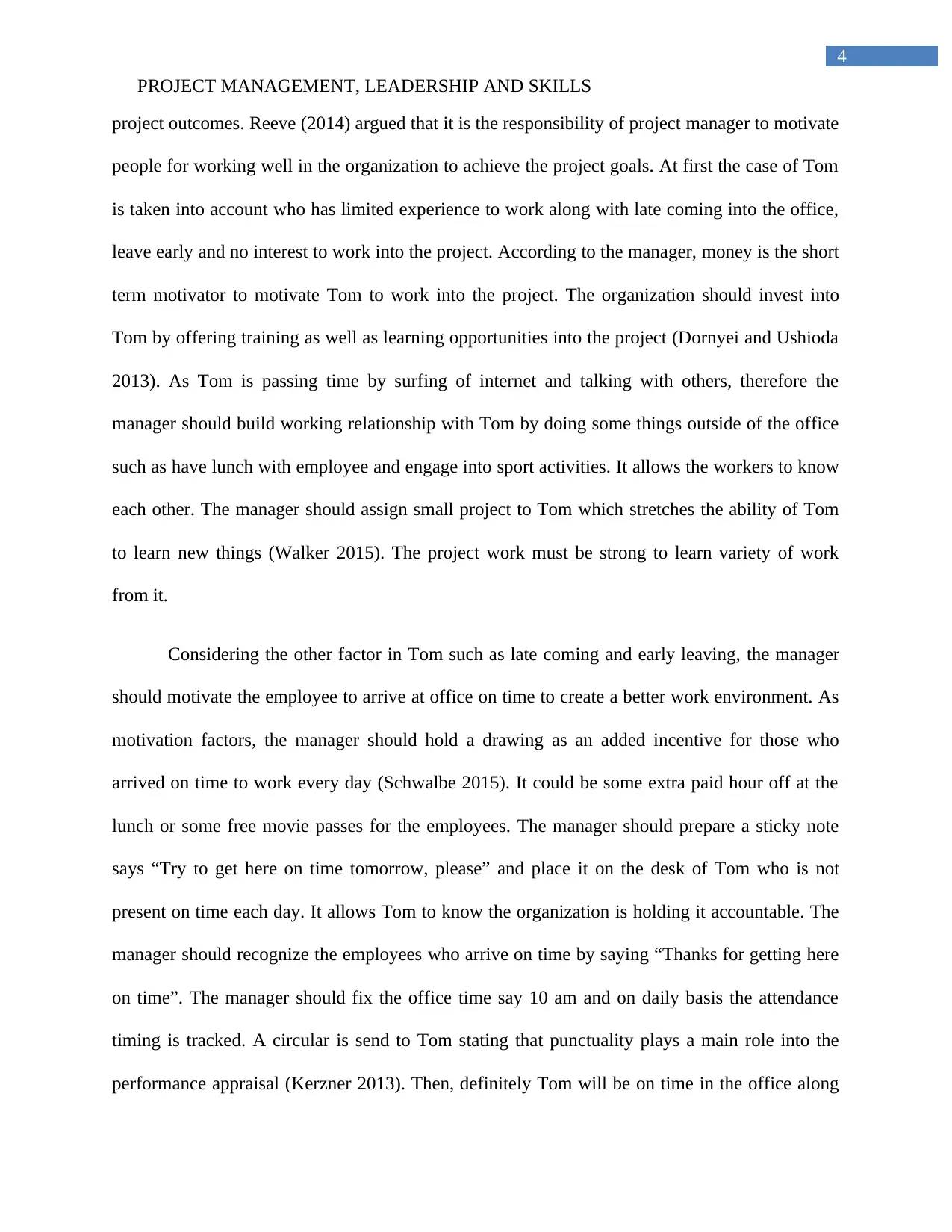
4
PROJECT MANAGEMENT, LEADERSHIP AND SKILLS
project outcomes. Reeve (2014) argued that it is the responsibility of project manager to motivate
people for working well in the organization to achieve the project goals. At first the case of Tom
is taken into account who has limited experience to work along with late coming into the office,
leave early and no interest to work into the project. According to the manager, money is the short
term motivator to motivate Tom to work into the project. The organization should invest into
Tom by offering training as well as learning opportunities into the project (Dornyei and Ushioda
2013). As Tom is passing time by surfing of internet and talking with others, therefore the
manager should build working relationship with Tom by doing some things outside of the office
such as have lunch with employee and engage into sport activities. It allows the workers to know
each other. The manager should assign small project to Tom which stretches the ability of Tom
to learn new things (Walker 2015). The project work must be strong to learn variety of work
from it.
Considering the other factor in Tom such as late coming and early leaving, the manager
should motivate the employee to arrive at office on time to create a better work environment. As
motivation factors, the manager should hold a drawing as an added incentive for those who
arrived on time to work every day (Schwalbe 2015). It could be some extra paid hour off at the
lunch or some free movie passes for the employees. The manager should prepare a sticky note
says “Try to get here on time tomorrow, please” and place it on the desk of Tom who is not
present on time each day. It allows Tom to know the organization is holding it accountable. The
manager should recognize the employees who arrive on time by saying “Thanks for getting here
on time”. The manager should fix the office time say 10 am and on daily basis the attendance
timing is tracked. A circular is send to Tom stating that punctuality plays a main role into the
performance appraisal (Kerzner 2013). Then, definitely Tom will be on time in the office along
PROJECT MANAGEMENT, LEADERSHIP AND SKILLS
project outcomes. Reeve (2014) argued that it is the responsibility of project manager to motivate
people for working well in the organization to achieve the project goals. At first the case of Tom
is taken into account who has limited experience to work along with late coming into the office,
leave early and no interest to work into the project. According to the manager, money is the short
term motivator to motivate Tom to work into the project. The organization should invest into
Tom by offering training as well as learning opportunities into the project (Dornyei and Ushioda
2013). As Tom is passing time by surfing of internet and talking with others, therefore the
manager should build working relationship with Tom by doing some things outside of the office
such as have lunch with employee and engage into sport activities. It allows the workers to know
each other. The manager should assign small project to Tom which stretches the ability of Tom
to learn new things (Walker 2015). The project work must be strong to learn variety of work
from it.
Considering the other factor in Tom such as late coming and early leaving, the manager
should motivate the employee to arrive at office on time to create a better work environment. As
motivation factors, the manager should hold a drawing as an added incentive for those who
arrived on time to work every day (Schwalbe 2015). It could be some extra paid hour off at the
lunch or some free movie passes for the employees. The manager should prepare a sticky note
says “Try to get here on time tomorrow, please” and place it on the desk of Tom who is not
present on time each day. It allows Tom to know the organization is holding it accountable. The
manager should recognize the employees who arrive on time by saying “Thanks for getting here
on time”. The manager should fix the office time say 10 am and on daily basis the attendance
timing is tracked. A circular is send to Tom stating that punctuality plays a main role into the
performance appraisal (Kerzner 2013). Then, definitely Tom will be on time in the office along
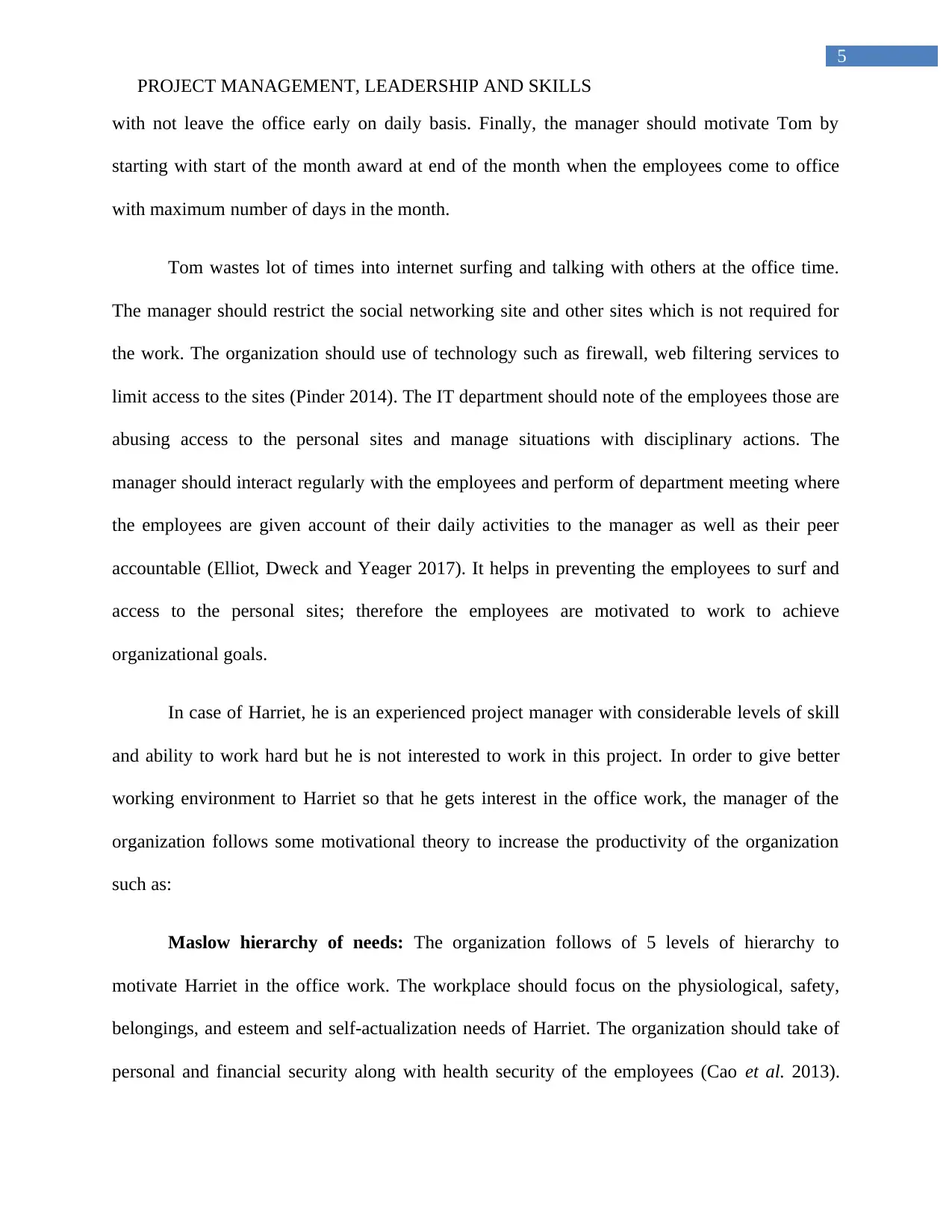
5
PROJECT MANAGEMENT, LEADERSHIP AND SKILLS
with not leave the office early on daily basis. Finally, the manager should motivate Tom by
starting with start of the month award at end of the month when the employees come to office
with maximum number of days in the month.
Tom wastes lot of times into internet surfing and talking with others at the office time.
The manager should restrict the social networking site and other sites which is not required for
the work. The organization should use of technology such as firewall, web filtering services to
limit access to the sites (Pinder 2014). The IT department should note of the employees those are
abusing access to the personal sites and manage situations with disciplinary actions. The
manager should interact regularly with the employees and perform of department meeting where
the employees are given account of their daily activities to the manager as well as their peer
accountable (Elliot, Dweck and Yeager 2017). It helps in preventing the employees to surf and
access to the personal sites; therefore the employees are motivated to work to achieve
organizational goals.
In case of Harriet, he is an experienced project manager with considerable levels of skill
and ability to work hard but he is not interested to work in this project. In order to give better
working environment to Harriet so that he gets interest in the office work, the manager of the
organization follows some motivational theory to increase the productivity of the organization
such as:
Maslow hierarchy of needs: The organization follows of 5 levels of hierarchy to
motivate Harriet in the office work. The workplace should focus on the physiological, safety,
belongings, and esteem and self-actualization needs of Harriet. The organization should take of
personal and financial security along with health security of the employees (Cao et al. 2013).
PROJECT MANAGEMENT, LEADERSHIP AND SKILLS
with not leave the office early on daily basis. Finally, the manager should motivate Tom by
starting with start of the month award at end of the month when the employees come to office
with maximum number of days in the month.
Tom wastes lot of times into internet surfing and talking with others at the office time.
The manager should restrict the social networking site and other sites which is not required for
the work. The organization should use of technology such as firewall, web filtering services to
limit access to the sites (Pinder 2014). The IT department should note of the employees those are
abusing access to the personal sites and manage situations with disciplinary actions. The
manager should interact regularly with the employees and perform of department meeting where
the employees are given account of their daily activities to the manager as well as their peer
accountable (Elliot, Dweck and Yeager 2017). It helps in preventing the employees to surf and
access to the personal sites; therefore the employees are motivated to work to achieve
organizational goals.
In case of Harriet, he is an experienced project manager with considerable levels of skill
and ability to work hard but he is not interested to work in this project. In order to give better
working environment to Harriet so that he gets interest in the office work, the manager of the
organization follows some motivational theory to increase the productivity of the organization
such as:
Maslow hierarchy of needs: The organization follows of 5 levels of hierarchy to
motivate Harriet in the office work. The workplace should focus on the physiological, safety,
belongings, and esteem and self-actualization needs of Harriet. The organization should take of
personal and financial security along with health security of the employees (Cao et al. 2013).
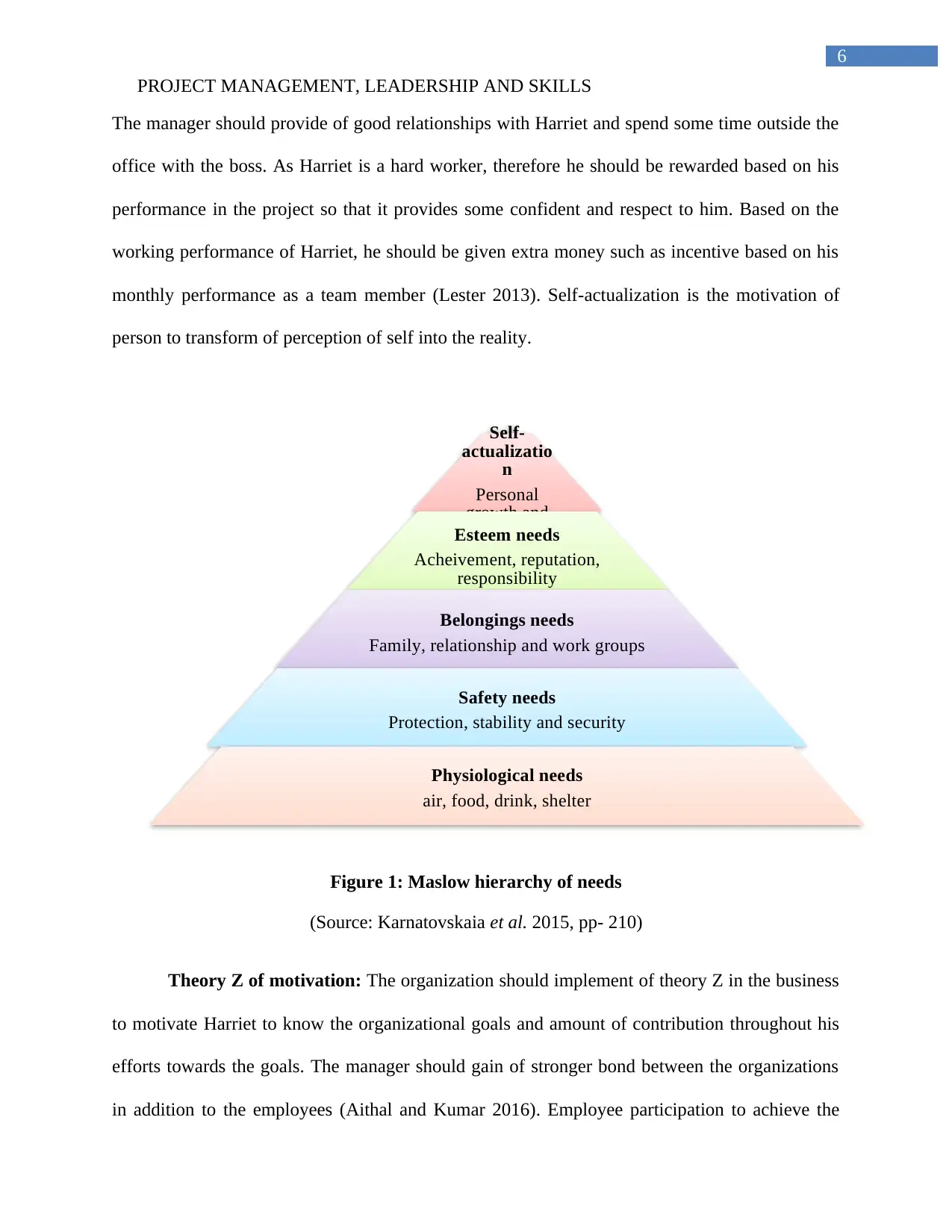
6
PROJECT MANAGEMENT, LEADERSHIP AND SKILLS
The manager should provide of good relationships with Harriet and spend some time outside the
office with the boss. As Harriet is a hard worker, therefore he should be rewarded based on his
performance in the project so that it provides some confident and respect to him. Based on the
working performance of Harriet, he should be given extra money such as incentive based on his
monthly performance as a team member (Lester 2013). Self-actualization is the motivation of
person to transform of perception of self into the reality.
Figure 1: Maslow hierarchy of needs
(Source: Karnatovskaia et al. 2015, pp- 210)
Theory Z of motivation: The organization should implement of theory Z in the business
to motivate Harriet to know the organizational goals and amount of contribution throughout his
efforts towards the goals. The manager should gain of stronger bond between the organizations
in addition to the employees (Aithal and Kumar 2016). Employee participation to achieve the
Self-
actualizatio
n
Personal
growth and
fulfillmentEsteem needs
Acheivement, reputation,
responsibility
Belongings needs
Family, relationship and work groups
Safety needs
Protection, stability and security
Physiological needs
air, food, drink, shelter
PROJECT MANAGEMENT, LEADERSHIP AND SKILLS
The manager should provide of good relationships with Harriet and spend some time outside the
office with the boss. As Harriet is a hard worker, therefore he should be rewarded based on his
performance in the project so that it provides some confident and respect to him. Based on the
working performance of Harriet, he should be given extra money such as incentive based on his
monthly performance as a team member (Lester 2013). Self-actualization is the motivation of
person to transform of perception of self into the reality.
Figure 1: Maslow hierarchy of needs
(Source: Karnatovskaia et al. 2015, pp- 210)
Theory Z of motivation: The organization should implement of theory Z in the business
to motivate Harriet to know the organizational goals and amount of contribution throughout his
efforts towards the goals. The manager should gain of stronger bond between the organizations
in addition to the employees (Aithal and Kumar 2016). Employee participation to achieve the
Self-
actualizatio
n
Personal
growth and
fulfillmentEsteem needs
Acheivement, reputation,
responsibility
Belongings needs
Family, relationship and work groups
Safety needs
Protection, stability and security
Physiological needs
air, food, drink, shelter
Paraphrase This Document
Need a fresh take? Get an instant paraphrase of this document with our AI Paraphraser
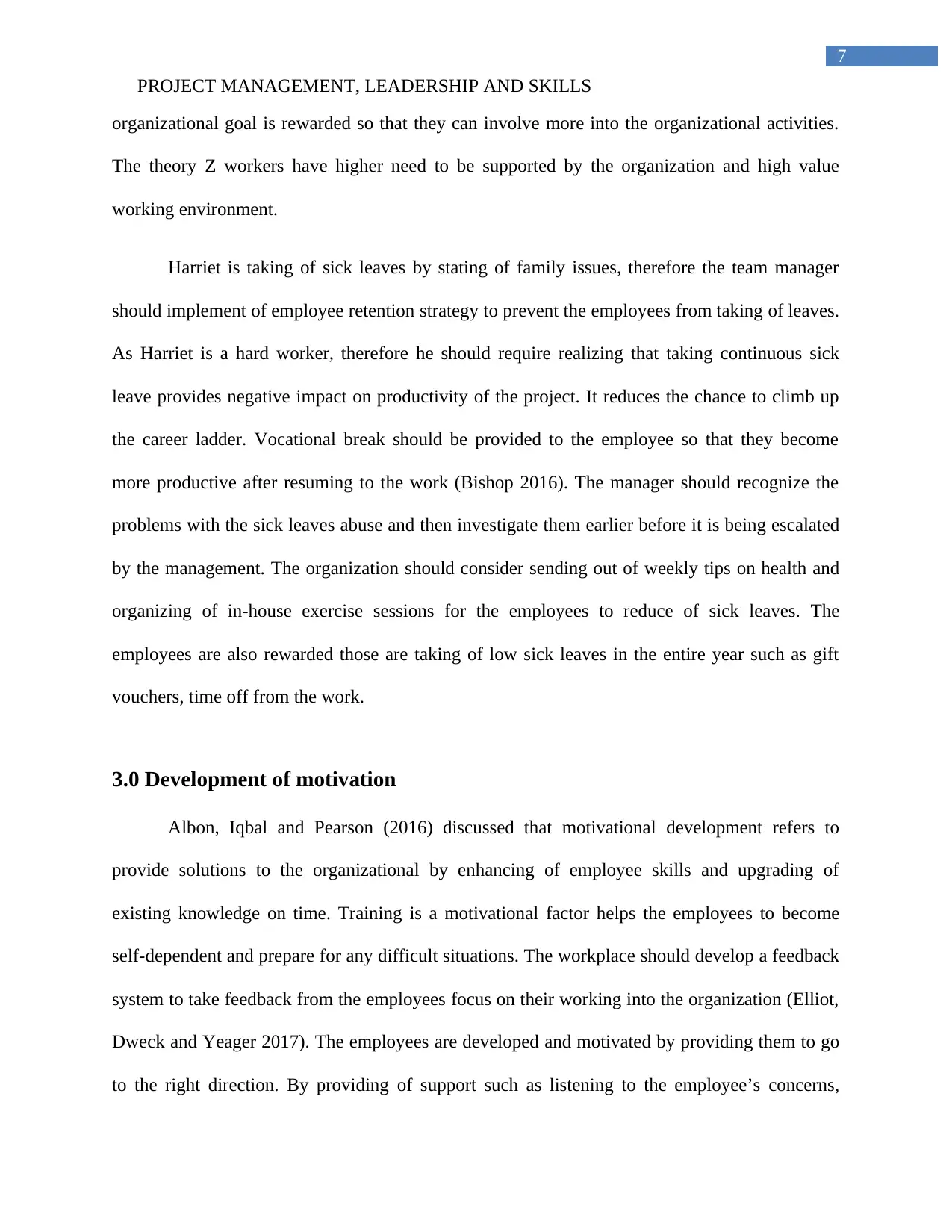
7
PROJECT MANAGEMENT, LEADERSHIP AND SKILLS
organizational goal is rewarded so that they can involve more into the organizational activities.
The theory Z workers have higher need to be supported by the organization and high value
working environment.
Harriet is taking of sick leaves by stating of family issues, therefore the team manager
should implement of employee retention strategy to prevent the employees from taking of leaves.
As Harriet is a hard worker, therefore he should require realizing that taking continuous sick
leave provides negative impact on productivity of the project. It reduces the chance to climb up
the career ladder. Vocational break should be provided to the employee so that they become
more productive after resuming to the work (Bishop 2016). The manager should recognize the
problems with the sick leaves abuse and then investigate them earlier before it is being escalated
by the management. The organization should consider sending out of weekly tips on health and
organizing of in-house exercise sessions for the employees to reduce of sick leaves. The
employees are also rewarded those are taking of low sick leaves in the entire year such as gift
vouchers, time off from the work.
3.0 Development of motivation
Albon, Iqbal and Pearson (2016) discussed that motivational development refers to
provide solutions to the organizational by enhancing of employee skills and upgrading of
existing knowledge on time. Training is a motivational factor helps the employees to become
self-dependent and prepare for any difficult situations. The workplace should develop a feedback
system to take feedback from the employees focus on their working into the organization (Elliot,
Dweck and Yeager 2017). The employees are developed and motivated by providing them to go
to the right direction. By providing of support such as listening to the employee’s concerns,
PROJECT MANAGEMENT, LEADERSHIP AND SKILLS
organizational goal is rewarded so that they can involve more into the organizational activities.
The theory Z workers have higher need to be supported by the organization and high value
working environment.
Harriet is taking of sick leaves by stating of family issues, therefore the team manager
should implement of employee retention strategy to prevent the employees from taking of leaves.
As Harriet is a hard worker, therefore he should require realizing that taking continuous sick
leave provides negative impact on productivity of the project. It reduces the chance to climb up
the career ladder. Vocational break should be provided to the employee so that they become
more productive after resuming to the work (Bishop 2016). The manager should recognize the
problems with the sick leaves abuse and then investigate them earlier before it is being escalated
by the management. The organization should consider sending out of weekly tips on health and
organizing of in-house exercise sessions for the employees to reduce of sick leaves. The
employees are also rewarded those are taking of low sick leaves in the entire year such as gift
vouchers, time off from the work.
3.0 Development of motivation
Albon, Iqbal and Pearson (2016) discussed that motivational development refers to
provide solutions to the organizational by enhancing of employee skills and upgrading of
existing knowledge on time. Training is a motivational factor helps the employees to become
self-dependent and prepare for any difficult situations. The workplace should develop a feedback
system to take feedback from the employees focus on their working into the organization (Elliot,
Dweck and Yeager 2017). The employees are developed and motivated by providing them to go
to the right direction. By providing of support such as listening to the employee’s concerns,
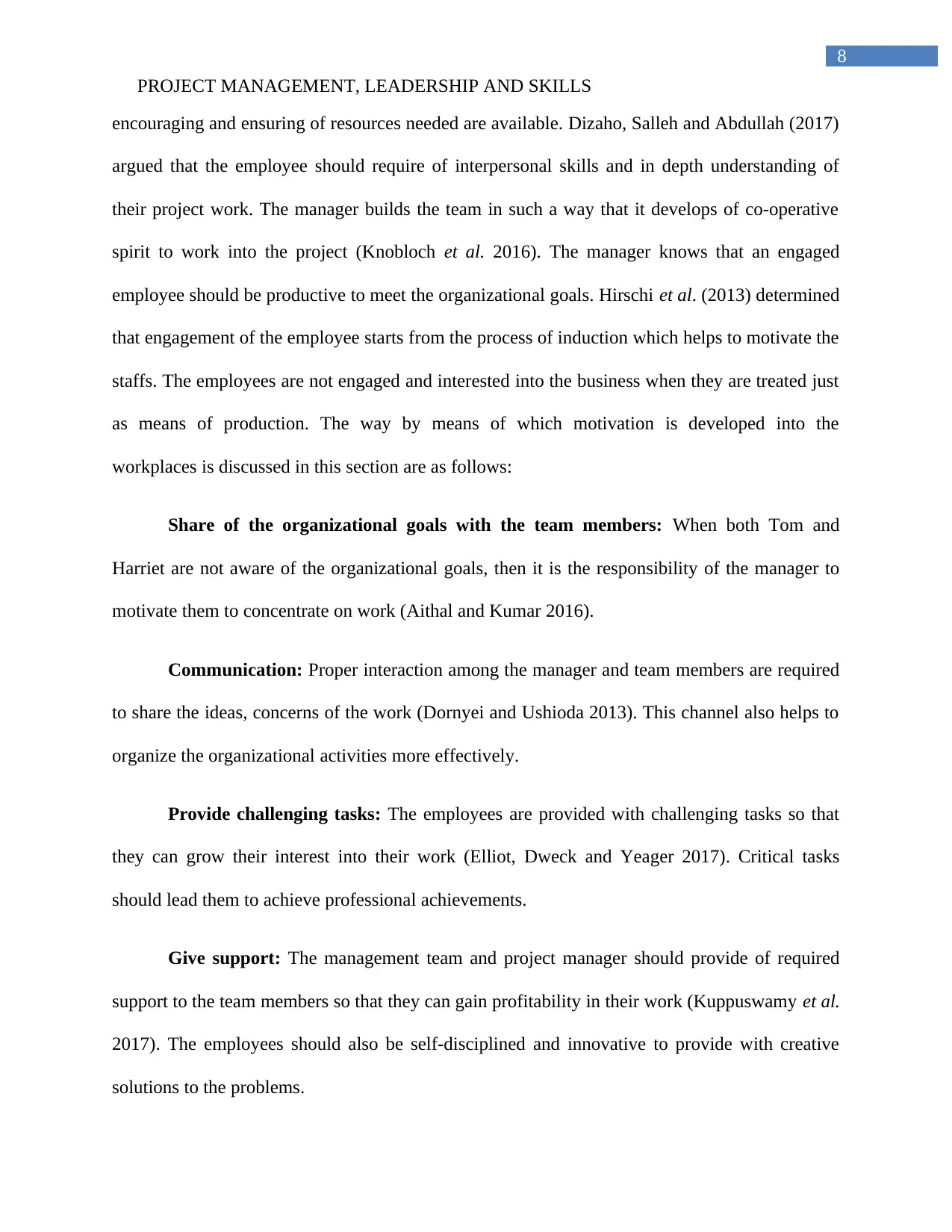
8
PROJECT MANAGEMENT, LEADERSHIP AND SKILLS
encouraging and ensuring of resources needed are available. Dizaho, Salleh and Abdullah (2017)
argued that the employee should require of interpersonal skills and in depth understanding of
their project work. The manager builds the team in such a way that it develops of co-operative
spirit to work into the project (Knobloch et al. 2016). The manager knows that an engaged
employee should be productive to meet the organizational goals. Hirschi et al. (2013) determined
that engagement of the employee starts from the process of induction which helps to motivate the
staffs. The employees are not engaged and interested into the business when they are treated just
as means of production. The way by means of which motivation is developed into the
workplaces is discussed in this section are as follows:
Share of the organizational goals with the team members: When both Tom and
Harriet are not aware of the organizational goals, then it is the responsibility of the manager to
motivate them to concentrate on work (Aithal and Kumar 2016).
Communication: Proper interaction among the manager and team members are required
to share the ideas, concerns of the work (Dornyei and Ushioda 2013). This channel also helps to
organize the organizational activities more effectively.
Provide challenging tasks: The employees are provided with challenging tasks so that
they can grow their interest into their work (Elliot, Dweck and Yeager 2017). Critical tasks
should lead them to achieve professional achievements.
Give support: The management team and project manager should provide of required
support to the team members so that they can gain profitability in their work (Kuppuswamy et al.
2017). The employees should also be self-disciplined and innovative to provide with creative
solutions to the problems.
PROJECT MANAGEMENT, LEADERSHIP AND SKILLS
encouraging and ensuring of resources needed are available. Dizaho, Salleh and Abdullah (2017)
argued that the employee should require of interpersonal skills and in depth understanding of
their project work. The manager builds the team in such a way that it develops of co-operative
spirit to work into the project (Knobloch et al. 2016). The manager knows that an engaged
employee should be productive to meet the organizational goals. Hirschi et al. (2013) determined
that engagement of the employee starts from the process of induction which helps to motivate the
staffs. The employees are not engaged and interested into the business when they are treated just
as means of production. The way by means of which motivation is developed into the
workplaces is discussed in this section are as follows:
Share of the organizational goals with the team members: When both Tom and
Harriet are not aware of the organizational goals, then it is the responsibility of the manager to
motivate them to concentrate on work (Aithal and Kumar 2016).
Communication: Proper interaction among the manager and team members are required
to share the ideas, concerns of the work (Dornyei and Ushioda 2013). This channel also helps to
organize the organizational activities more effectively.
Provide challenging tasks: The employees are provided with challenging tasks so that
they can grow their interest into their work (Elliot, Dweck and Yeager 2017). Critical tasks
should lead them to achieve professional achievements.
Give support: The management team and project manager should provide of required
support to the team members so that they can gain profitability in their work (Kuppuswamy et al.
2017). The employees should also be self-disciplined and innovative to provide with creative
solutions to the problems.
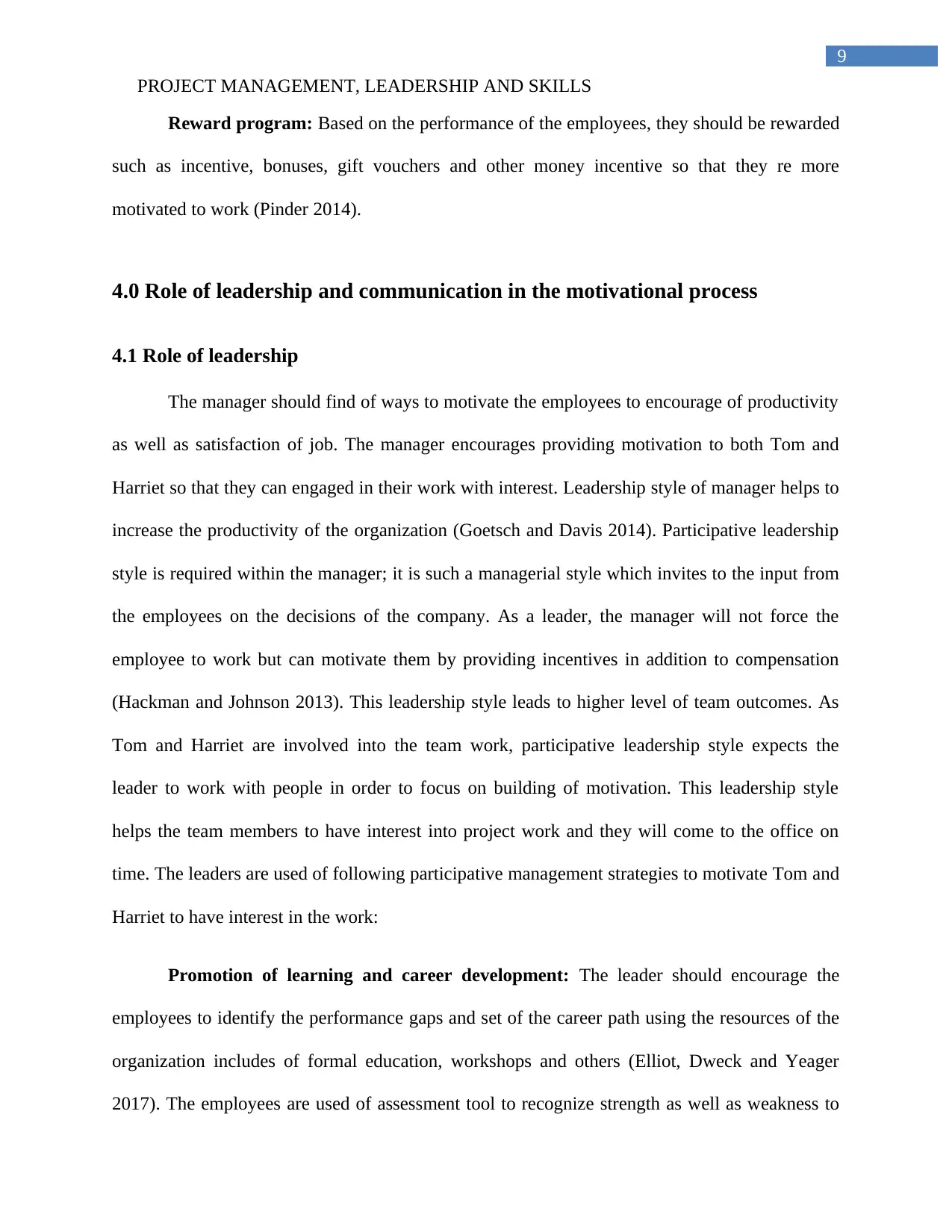
9
PROJECT MANAGEMENT, LEADERSHIP AND SKILLS
Reward program: Based on the performance of the employees, they should be rewarded
such as incentive, bonuses, gift vouchers and other money incentive so that they re more
motivated to work (Pinder 2014).
4.0 Role of leadership and communication in the motivational process
4.1 Role of leadership
The manager should find of ways to motivate the employees to encourage of productivity
as well as satisfaction of job. The manager encourages providing motivation to both Tom and
Harriet so that they can engaged in their work with interest. Leadership style of manager helps to
increase the productivity of the organization (Goetsch and Davis 2014). Participative leadership
style is required within the manager; it is such a managerial style which invites to the input from
the employees on the decisions of the company. As a leader, the manager will not force the
employee to work but can motivate them by providing incentives in addition to compensation
(Hackman and Johnson 2013). This leadership style leads to higher level of team outcomes. As
Tom and Harriet are involved into the team work, participative leadership style expects the
leader to work with people in order to focus on building of motivation. This leadership style
helps the team members to have interest into project work and they will come to the office on
time. The leaders are used of following participative management strategies to motivate Tom and
Harriet to have interest in the work:
Promotion of learning and career development: The leader should encourage the
employees to identify the performance gaps and set of the career path using the resources of the
organization includes of formal education, workshops and others (Elliot, Dweck and Yeager
2017). The employees are used of assessment tool to recognize strength as well as weakness to
PROJECT MANAGEMENT, LEADERSHIP AND SKILLS
Reward program: Based on the performance of the employees, they should be rewarded
such as incentive, bonuses, gift vouchers and other money incentive so that they re more
motivated to work (Pinder 2014).
4.0 Role of leadership and communication in the motivational process
4.1 Role of leadership
The manager should find of ways to motivate the employees to encourage of productivity
as well as satisfaction of job. The manager encourages providing motivation to both Tom and
Harriet so that they can engaged in their work with interest. Leadership style of manager helps to
increase the productivity of the organization (Goetsch and Davis 2014). Participative leadership
style is required within the manager; it is such a managerial style which invites to the input from
the employees on the decisions of the company. As a leader, the manager will not force the
employee to work but can motivate them by providing incentives in addition to compensation
(Hackman and Johnson 2013). This leadership style leads to higher level of team outcomes. As
Tom and Harriet are involved into the team work, participative leadership style expects the
leader to work with people in order to focus on building of motivation. This leadership style
helps the team members to have interest into project work and they will come to the office on
time. The leaders are used of following participative management strategies to motivate Tom and
Harriet to have interest in the work:
Promotion of learning and career development: The leader should encourage the
employees to identify the performance gaps and set of the career path using the resources of the
organization includes of formal education, workshops and others (Elliot, Dweck and Yeager
2017). The employees are used of assessment tool to recognize strength as well as weakness to
Secure Best Marks with AI Grader
Need help grading? Try our AI Grader for instant feedback on your assignments.
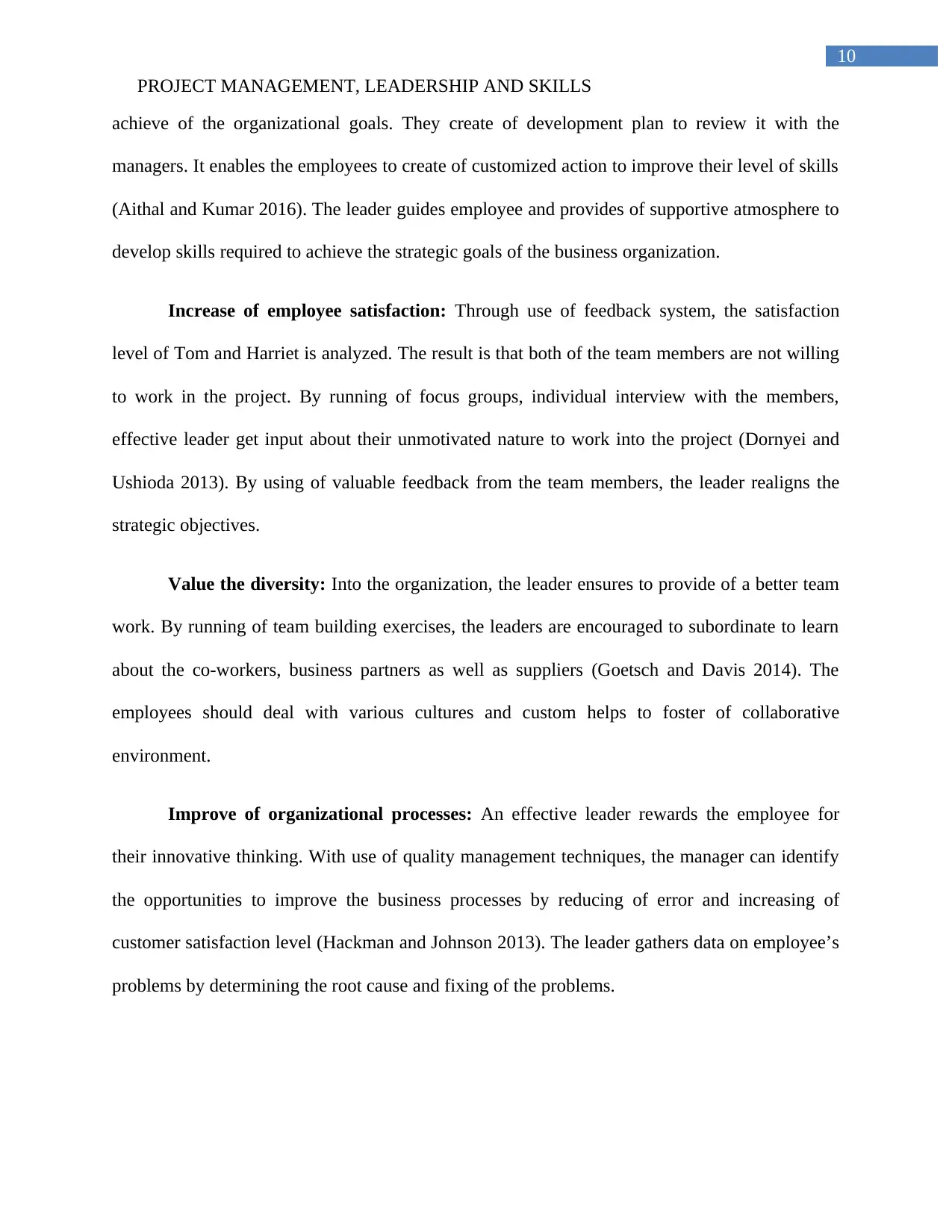
10
PROJECT MANAGEMENT, LEADERSHIP AND SKILLS
achieve of the organizational goals. They create of development plan to review it with the
managers. It enables the employees to create of customized action to improve their level of skills
(Aithal and Kumar 2016). The leader guides employee and provides of supportive atmosphere to
develop skills required to achieve the strategic goals of the business organization.
Increase of employee satisfaction: Through use of feedback system, the satisfaction
level of Tom and Harriet is analyzed. The result is that both of the team members are not willing
to work in the project. By running of focus groups, individual interview with the members,
effective leader get input about their unmotivated nature to work into the project (Dornyei and
Ushioda 2013). By using of valuable feedback from the team members, the leader realigns the
strategic objectives.
Value the diversity: Into the organization, the leader ensures to provide of a better team
work. By running of team building exercises, the leaders are encouraged to subordinate to learn
about the co-workers, business partners as well as suppliers (Goetsch and Davis 2014). The
employees should deal with various cultures and custom helps to foster of collaborative
environment.
Improve of organizational processes: An effective leader rewards the employee for
their innovative thinking. With use of quality management techniques, the manager can identify
the opportunities to improve the business processes by reducing of error and increasing of
customer satisfaction level (Hackman and Johnson 2013). The leader gathers data on employee’s
problems by determining the root cause and fixing of the problems.
PROJECT MANAGEMENT, LEADERSHIP AND SKILLS
achieve of the organizational goals. They create of development plan to review it with the
managers. It enables the employees to create of customized action to improve their level of skills
(Aithal and Kumar 2016). The leader guides employee and provides of supportive atmosphere to
develop skills required to achieve the strategic goals of the business organization.
Increase of employee satisfaction: Through use of feedback system, the satisfaction
level of Tom and Harriet is analyzed. The result is that both of the team members are not willing
to work in the project. By running of focus groups, individual interview with the members,
effective leader get input about their unmotivated nature to work into the project (Dornyei and
Ushioda 2013). By using of valuable feedback from the team members, the leader realigns the
strategic objectives.
Value the diversity: Into the organization, the leader ensures to provide of a better team
work. By running of team building exercises, the leaders are encouraged to subordinate to learn
about the co-workers, business partners as well as suppliers (Goetsch and Davis 2014). The
employees should deal with various cultures and custom helps to foster of collaborative
environment.
Improve of organizational processes: An effective leader rewards the employee for
their innovative thinking. With use of quality management techniques, the manager can identify
the opportunities to improve the business processes by reducing of error and increasing of
customer satisfaction level (Hackman and Johnson 2013). The leader gathers data on employee’s
problems by determining the root cause and fixing of the problems.
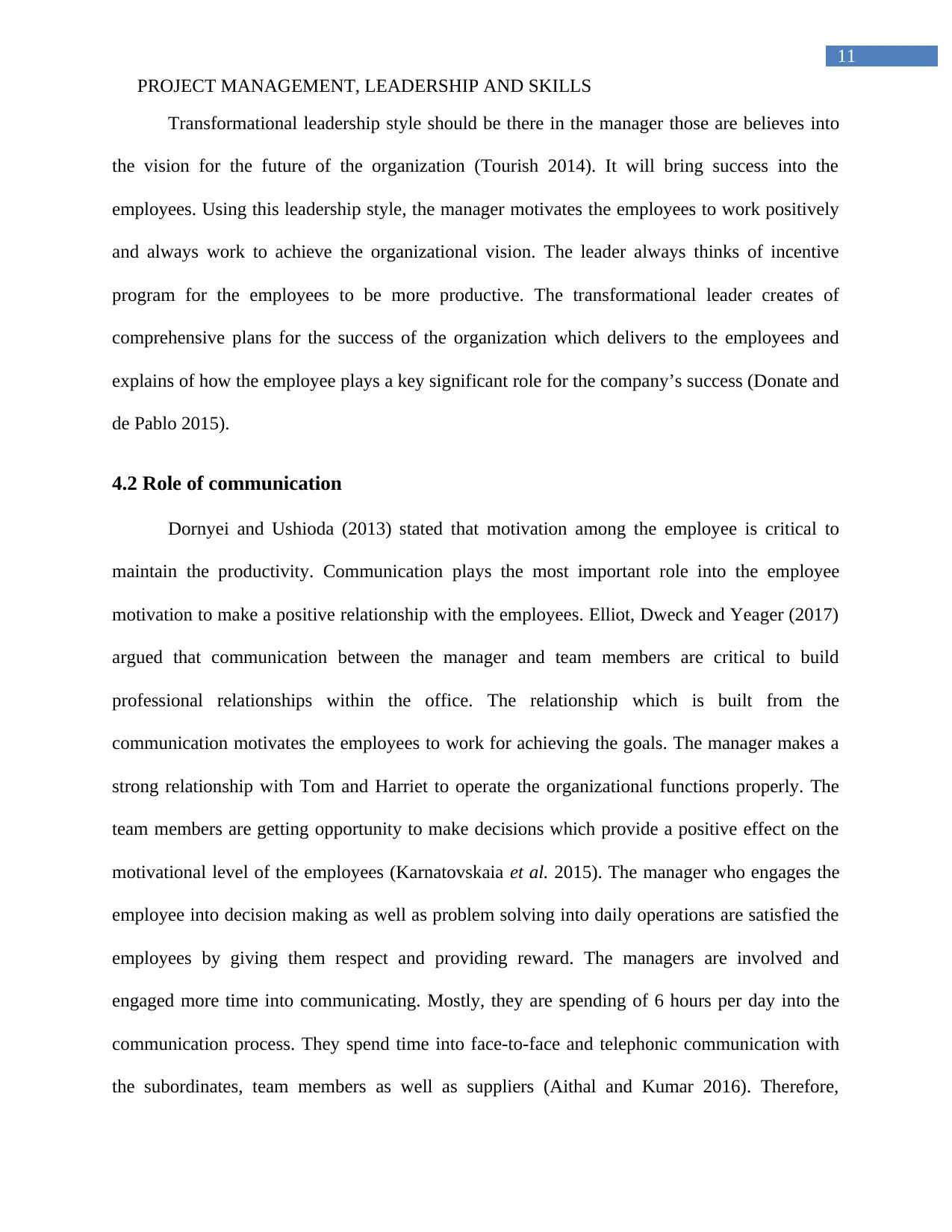
11
PROJECT MANAGEMENT, LEADERSHIP AND SKILLS
Transformational leadership style should be there in the manager those are believes into
the vision for the future of the organization (Tourish 2014). It will bring success into the
employees. Using this leadership style, the manager motivates the employees to work positively
and always work to achieve the organizational vision. The leader always thinks of incentive
program for the employees to be more productive. The transformational leader creates of
comprehensive plans for the success of the organization which delivers to the employees and
explains of how the employee plays a key significant role for the company’s success (Donate and
de Pablo 2015).
4.2 Role of communication
Dornyei and Ushioda (2013) stated that motivation among the employee is critical to
maintain the productivity. Communication plays the most important role into the employee
motivation to make a positive relationship with the employees. Elliot, Dweck and Yeager (2017)
argued that communication between the manager and team members are critical to build
professional relationships within the office. The relationship which is built from the
communication motivates the employees to work for achieving the goals. The manager makes a
strong relationship with Tom and Harriet to operate the organizational functions properly. The
team members are getting opportunity to make decisions which provide a positive effect on the
motivational level of the employees (Karnatovskaia et al. 2015). The manager who engages the
employee into decision making as well as problem solving into daily operations are satisfied the
employees by giving them respect and providing reward. The managers are involved and
engaged more time into communicating. Mostly, they are spending of 6 hours per day into the
communication process. They spend time into face-to-face and telephonic communication with
the subordinates, team members as well as suppliers (Aithal and Kumar 2016). Therefore,
PROJECT MANAGEMENT, LEADERSHIP AND SKILLS
Transformational leadership style should be there in the manager those are believes into
the vision for the future of the organization (Tourish 2014). It will bring success into the
employees. Using this leadership style, the manager motivates the employees to work positively
and always work to achieve the organizational vision. The leader always thinks of incentive
program for the employees to be more productive. The transformational leader creates of
comprehensive plans for the success of the organization which delivers to the employees and
explains of how the employee plays a key significant role for the company’s success (Donate and
de Pablo 2015).
4.2 Role of communication
Dornyei and Ushioda (2013) stated that motivation among the employee is critical to
maintain the productivity. Communication plays the most important role into the employee
motivation to make a positive relationship with the employees. Elliot, Dweck and Yeager (2017)
argued that communication between the manager and team members are critical to build
professional relationships within the office. The relationship which is built from the
communication motivates the employees to work for achieving the goals. The manager makes a
strong relationship with Tom and Harriet to operate the organizational functions properly. The
team members are getting opportunity to make decisions which provide a positive effect on the
motivational level of the employees (Karnatovskaia et al. 2015). The manager who engages the
employee into decision making as well as problem solving into daily operations are satisfied the
employees by giving them respect and providing reward. The managers are involved and
engaged more time into communicating. Mostly, they are spending of 6 hours per day into the
communication process. They spend time into face-to-face and telephonic communication with
the subordinates, team members as well as suppliers (Aithal and Kumar 2016). Therefore,
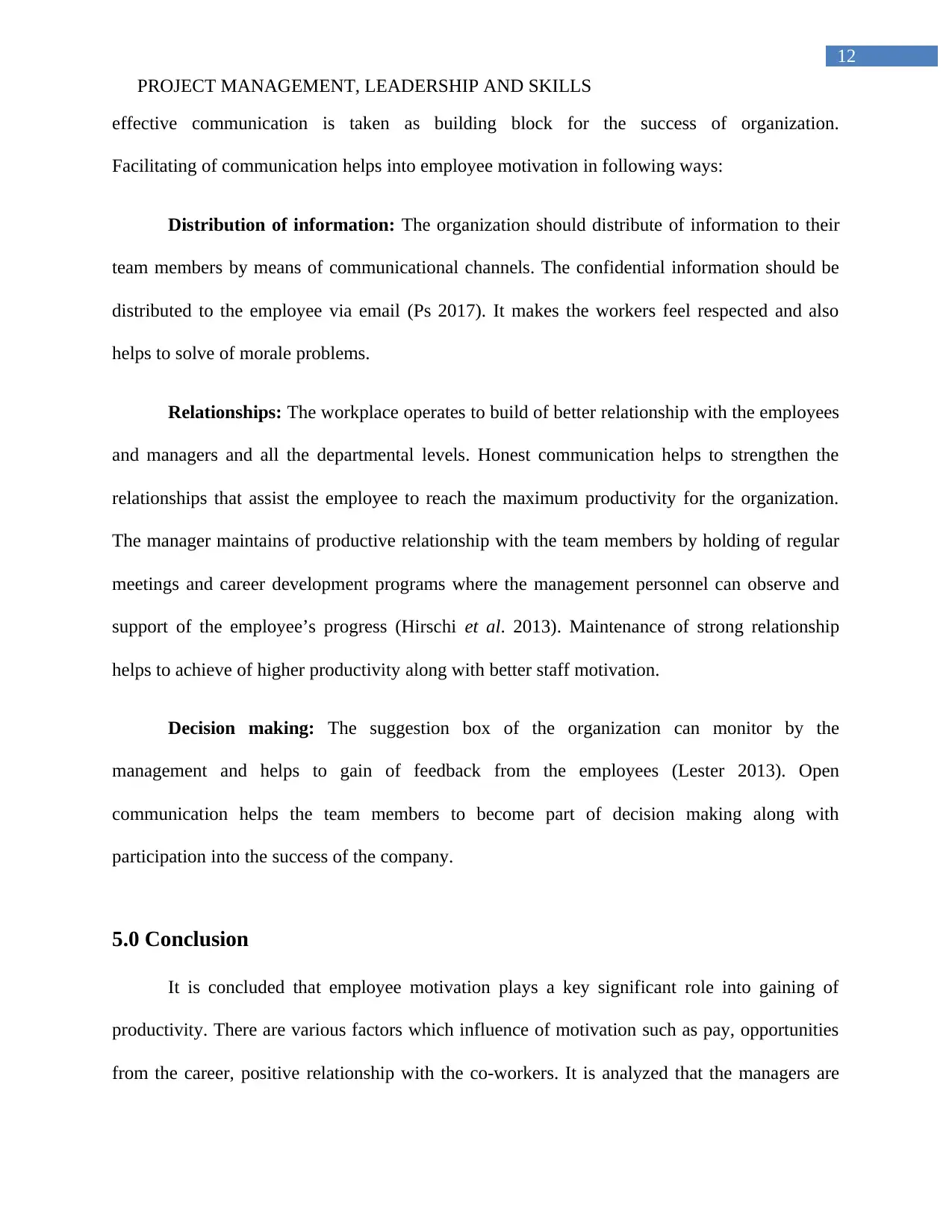
12
PROJECT MANAGEMENT, LEADERSHIP AND SKILLS
effective communication is taken as building block for the success of organization.
Facilitating of communication helps into employee motivation in following ways:
Distribution of information: The organization should distribute of information to their
team members by means of communicational channels. The confidential information should be
distributed to the employee via email (Ps 2017). It makes the workers feel respected and also
helps to solve of morale problems.
Relationships: The workplace operates to build of better relationship with the employees
and managers and all the departmental levels. Honest communication helps to strengthen the
relationships that assist the employee to reach the maximum productivity for the organization.
The manager maintains of productive relationship with the team members by holding of regular
meetings and career development programs where the management personnel can observe and
support of the employee’s progress (Hirschi et al. 2013). Maintenance of strong relationship
helps to achieve of higher productivity along with better staff motivation.
Decision making: The suggestion box of the organization can monitor by the
management and helps to gain of feedback from the employees (Lester 2013). Open
communication helps the team members to become part of decision making along with
participation into the success of the company.
5.0 Conclusion
It is concluded that employee motivation plays a key significant role into gaining of
productivity. There are various factors which influence of motivation such as pay, opportunities
from the career, positive relationship with the co-workers. It is analyzed that the managers are
PROJECT MANAGEMENT, LEADERSHIP AND SKILLS
effective communication is taken as building block for the success of organization.
Facilitating of communication helps into employee motivation in following ways:
Distribution of information: The organization should distribute of information to their
team members by means of communicational channels. The confidential information should be
distributed to the employee via email (Ps 2017). It makes the workers feel respected and also
helps to solve of morale problems.
Relationships: The workplace operates to build of better relationship with the employees
and managers and all the departmental levels. Honest communication helps to strengthen the
relationships that assist the employee to reach the maximum productivity for the organization.
The manager maintains of productive relationship with the team members by holding of regular
meetings and career development programs where the management personnel can observe and
support of the employee’s progress (Hirschi et al. 2013). Maintenance of strong relationship
helps to achieve of higher productivity along with better staff motivation.
Decision making: The suggestion box of the organization can monitor by the
management and helps to gain of feedback from the employees (Lester 2013). Open
communication helps the team members to become part of decision making along with
participation into the success of the company.
5.0 Conclusion
It is concluded that employee motivation plays a key significant role into gaining of
productivity. There are various factors which influence of motivation such as pay, opportunities
from the career, positive relationship with the co-workers. It is analyzed that the managers are
Paraphrase This Document
Need a fresh take? Get an instant paraphrase of this document with our AI Paraphraser
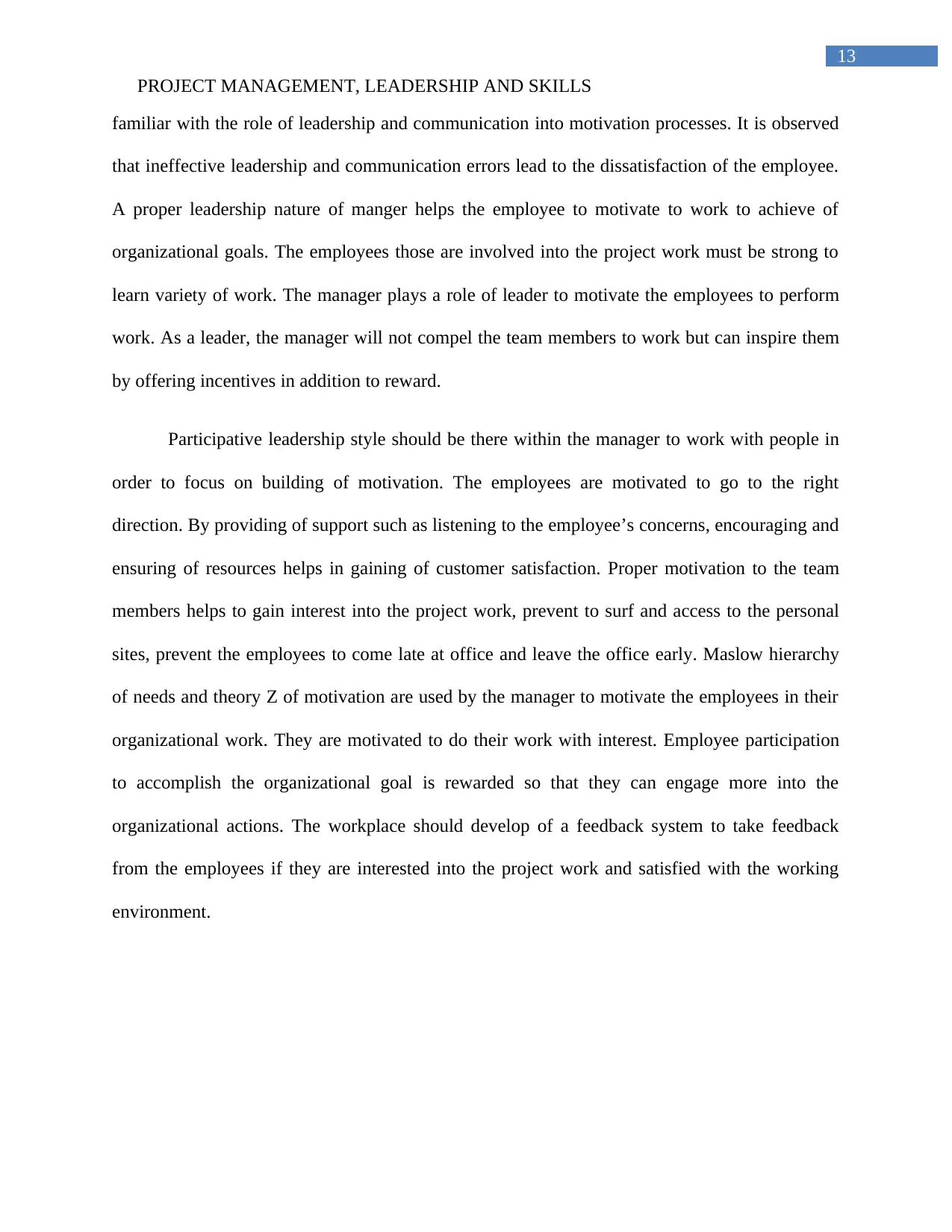
13
PROJECT MANAGEMENT, LEADERSHIP AND SKILLS
familiar with the role of leadership and communication into motivation processes. It is observed
that ineffective leadership and communication errors lead to the dissatisfaction of the employee.
A proper leadership nature of manger helps the employee to motivate to work to achieve of
organizational goals. The employees those are involved into the project work must be strong to
learn variety of work. The manager plays a role of leader to motivate the employees to perform
work. As a leader, the manager will not compel the team members to work but can inspire them
by offering incentives in addition to reward.
Participative leadership style should be there within the manager to work with people in
order to focus on building of motivation. The employees are motivated to go to the right
direction. By providing of support such as listening to the employee’s concerns, encouraging and
ensuring of resources helps in gaining of customer satisfaction. Proper motivation to the team
members helps to gain interest into the project work, prevent to surf and access to the personal
sites, prevent the employees to come late at office and leave the office early. Maslow hierarchy
of needs and theory Z of motivation are used by the manager to motivate the employees in their
organizational work. They are motivated to do their work with interest. Employee participation
to accomplish the organizational goal is rewarded so that they can engage more into the
organizational actions. The workplace should develop of a feedback system to take feedback
from the employees if they are interested into the project work and satisfied with the working
environment.
PROJECT MANAGEMENT, LEADERSHIP AND SKILLS
familiar with the role of leadership and communication into motivation processes. It is observed
that ineffective leadership and communication errors lead to the dissatisfaction of the employee.
A proper leadership nature of manger helps the employee to motivate to work to achieve of
organizational goals. The employees those are involved into the project work must be strong to
learn variety of work. The manager plays a role of leader to motivate the employees to perform
work. As a leader, the manager will not compel the team members to work but can inspire them
by offering incentives in addition to reward.
Participative leadership style should be there within the manager to work with people in
order to focus on building of motivation. The employees are motivated to go to the right
direction. By providing of support such as listening to the employee’s concerns, encouraging and
ensuring of resources helps in gaining of customer satisfaction. Proper motivation to the team
members helps to gain interest into the project work, prevent to surf and access to the personal
sites, prevent the employees to come late at office and leave the office early. Maslow hierarchy
of needs and theory Z of motivation are used by the manager to motivate the employees in their
organizational work. They are motivated to do their work with interest. Employee participation
to accomplish the organizational goal is rewarded so that they can engage more into the
organizational actions. The workplace should develop of a feedback system to take feedback
from the employees if they are interested into the project work and satisfied with the working
environment.
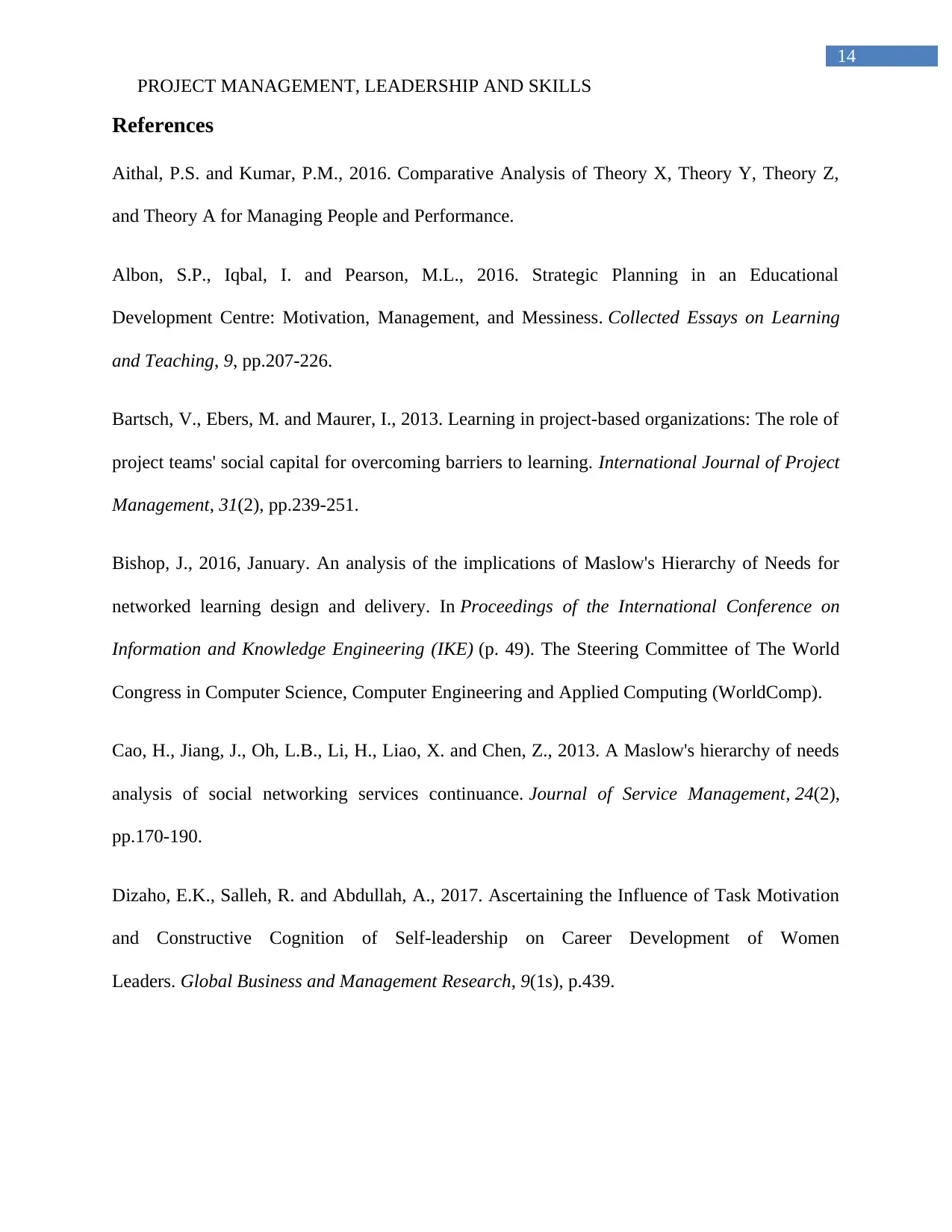
14
PROJECT MANAGEMENT, LEADERSHIP AND SKILLS
References
Aithal, P.S. and Kumar, P.M., 2016. Comparative Analysis of Theory X, Theory Y, Theory Z,
and Theory A for Managing People and Performance.
Albon, S.P., Iqbal, I. and Pearson, M.L., 2016. Strategic Planning in an Educational
Development Centre: Motivation, Management, and Messiness. Collected Essays on Learning
and Teaching, 9, pp.207-226.
Bartsch, V., Ebers, M. and Maurer, I., 2013. Learning in project-based organizations: The role of
project teams' social capital for overcoming barriers to learning. International Journal of Project
Management, 31(2), pp.239-251.
Bishop, J., 2016, January. An analysis of the implications of Maslow's Hierarchy of Needs for
networked learning design and delivery. In Proceedings of the International Conference on
Information and Knowledge Engineering (IKE) (p. 49). The Steering Committee of The World
Congress in Computer Science, Computer Engineering and Applied Computing (WorldComp).
Cao, H., Jiang, J., Oh, L.B., Li, H., Liao, X. and Chen, Z., 2013. A Maslow's hierarchy of needs
analysis of social networking services continuance. Journal of Service Management, 24(2),
pp.170-190.
Dizaho, E.K., Salleh, R. and Abdullah, A., 2017. Ascertaining the Influence of Task Motivation
and Constructive Cognition of Self-leadership on Career Development of Women
Leaders. Global Business and Management Research, 9(1s), p.439.
PROJECT MANAGEMENT, LEADERSHIP AND SKILLS
References
Aithal, P.S. and Kumar, P.M., 2016. Comparative Analysis of Theory X, Theory Y, Theory Z,
and Theory A for Managing People and Performance.
Albon, S.P., Iqbal, I. and Pearson, M.L., 2016. Strategic Planning in an Educational
Development Centre: Motivation, Management, and Messiness. Collected Essays on Learning
and Teaching, 9, pp.207-226.
Bartsch, V., Ebers, M. and Maurer, I., 2013. Learning in project-based organizations: The role of
project teams' social capital for overcoming barriers to learning. International Journal of Project
Management, 31(2), pp.239-251.
Bishop, J., 2016, January. An analysis of the implications of Maslow's Hierarchy of Needs for
networked learning design and delivery. In Proceedings of the International Conference on
Information and Knowledge Engineering (IKE) (p. 49). The Steering Committee of The World
Congress in Computer Science, Computer Engineering and Applied Computing (WorldComp).
Cao, H., Jiang, J., Oh, L.B., Li, H., Liao, X. and Chen, Z., 2013. A Maslow's hierarchy of needs
analysis of social networking services continuance. Journal of Service Management, 24(2),
pp.170-190.
Dizaho, E.K., Salleh, R. and Abdullah, A., 2017. Ascertaining the Influence of Task Motivation
and Constructive Cognition of Self-leadership on Career Development of Women
Leaders. Global Business and Management Research, 9(1s), p.439.
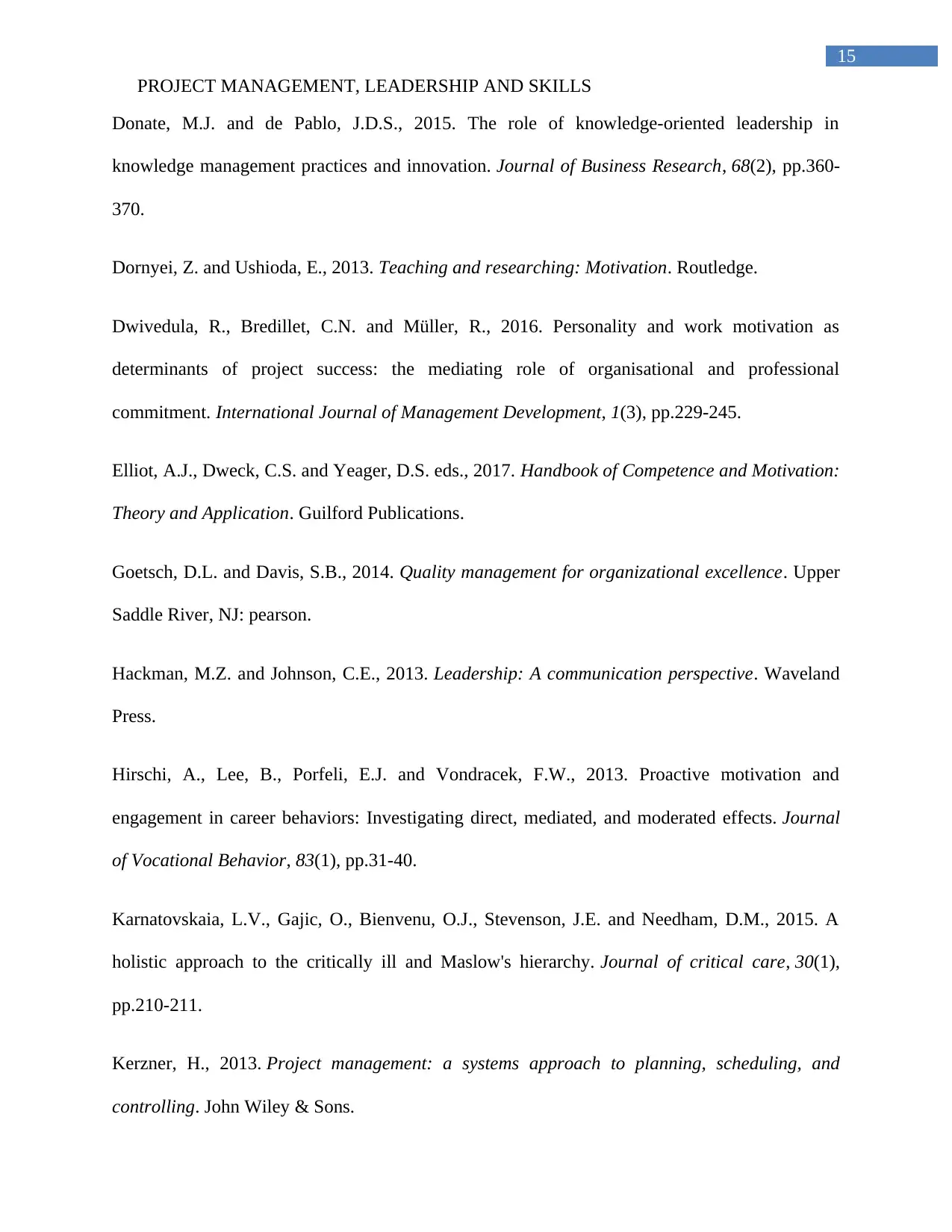
15
PROJECT MANAGEMENT, LEADERSHIP AND SKILLS
Donate, M.J. and de Pablo, J.D.S., 2015. The role of knowledge-oriented leadership in
knowledge management practices and innovation. Journal of Business Research, 68(2), pp.360-
370.
Dornyei, Z. and Ushioda, E., 2013. Teaching and researching: Motivation. Routledge.
Dwivedula, R., Bredillet, C.N. and Müller, R., 2016. Personality and work motivation as
determinants of project success: the mediating role of organisational and professional
commitment. International Journal of Management Development, 1(3), pp.229-245.
Elliot, A.J., Dweck, C.S. and Yeager, D.S. eds., 2017. Handbook of Competence and Motivation:
Theory and Application. Guilford Publications.
Goetsch, D.L. and Davis, S.B., 2014. Quality management for organizational excellence. Upper
Saddle River, NJ: pearson.
Hackman, M.Z. and Johnson, C.E., 2013. Leadership: A communication perspective. Waveland
Press.
Hirschi, A., Lee, B., Porfeli, E.J. and Vondracek, F.W., 2013. Proactive motivation and
engagement in career behaviors: Investigating direct, mediated, and moderated effects. Journal
of Vocational Behavior, 83(1), pp.31-40.
Karnatovskaia, L.V., Gajic, O., Bienvenu, O.J., Stevenson, J.E. and Needham, D.M., 2015. A
holistic approach to the critically ill and Maslow's hierarchy. Journal of critical care, 30(1),
pp.210-211.
Kerzner, H., 2013. Project management: a systems approach to planning, scheduling, and
controlling. John Wiley & Sons.
PROJECT MANAGEMENT, LEADERSHIP AND SKILLS
Donate, M.J. and de Pablo, J.D.S., 2015. The role of knowledge-oriented leadership in
knowledge management practices and innovation. Journal of Business Research, 68(2), pp.360-
370.
Dornyei, Z. and Ushioda, E., 2013. Teaching and researching: Motivation. Routledge.
Dwivedula, R., Bredillet, C.N. and Müller, R., 2016. Personality and work motivation as
determinants of project success: the mediating role of organisational and professional
commitment. International Journal of Management Development, 1(3), pp.229-245.
Elliot, A.J., Dweck, C.S. and Yeager, D.S. eds., 2017. Handbook of Competence and Motivation:
Theory and Application. Guilford Publications.
Goetsch, D.L. and Davis, S.B., 2014. Quality management for organizational excellence. Upper
Saddle River, NJ: pearson.
Hackman, M.Z. and Johnson, C.E., 2013. Leadership: A communication perspective. Waveland
Press.
Hirschi, A., Lee, B., Porfeli, E.J. and Vondracek, F.W., 2013. Proactive motivation and
engagement in career behaviors: Investigating direct, mediated, and moderated effects. Journal
of Vocational Behavior, 83(1), pp.31-40.
Karnatovskaia, L.V., Gajic, O., Bienvenu, O.J., Stevenson, J.E. and Needham, D.M., 2015. A
holistic approach to the critically ill and Maslow's hierarchy. Journal of critical care, 30(1),
pp.210-211.
Kerzner, H., 2013. Project management: a systems approach to planning, scheduling, and
controlling. John Wiley & Sons.
Secure Best Marks with AI Grader
Need help grading? Try our AI Grader for instant feedback on your assignments.
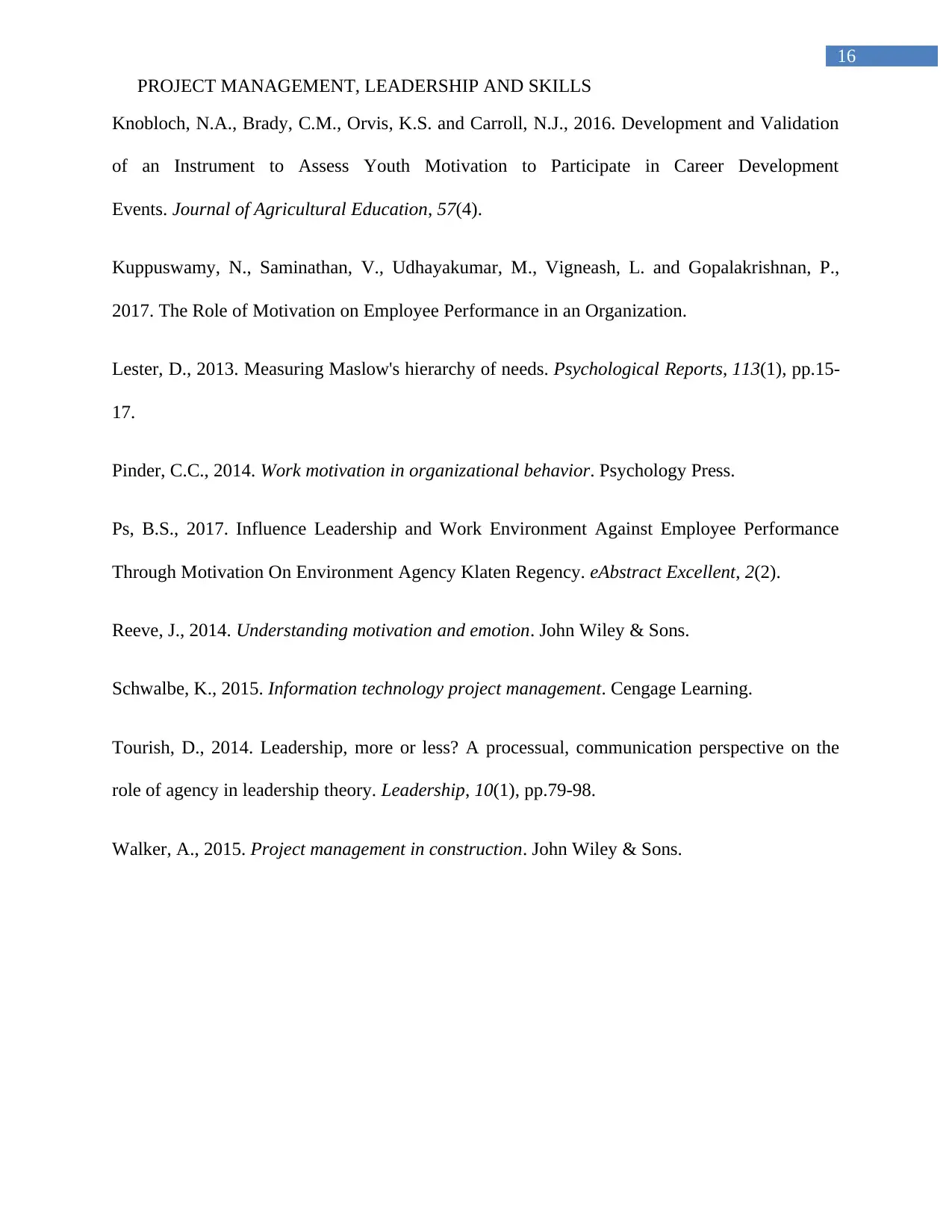
16
PROJECT MANAGEMENT, LEADERSHIP AND SKILLS
Knobloch, N.A., Brady, C.M., Orvis, K.S. and Carroll, N.J., 2016. Development and Validation
of an Instrument to Assess Youth Motivation to Participate in Career Development
Events. Journal of Agricultural Education, 57(4).
Kuppuswamy, N., Saminathan, V., Udhayakumar, M., Vigneash, L. and Gopalakrishnan, P.,
2017. The Role of Motivation on Employee Performance in an Organization.
Lester, D., 2013. Measuring Maslow's hierarchy of needs. Psychological Reports, 113(1), pp.15-
17.
Pinder, C.C., 2014. Work motivation in organizational behavior. Psychology Press.
Ps, B.S., 2017. Influence Leadership and Work Environment Against Employee Performance
Through Motivation On Environment Agency Klaten Regency. eAbstract Excellent, 2(2).
Reeve, J., 2014. Understanding motivation and emotion. John Wiley & Sons.
Schwalbe, K., 2015. Information technology project management. Cengage Learning.
Tourish, D., 2014. Leadership, more or less? A processual, communication perspective on the
role of agency in leadership theory. Leadership, 10(1), pp.79-98.
Walker, A., 2015. Project management in construction. John Wiley & Sons.
PROJECT MANAGEMENT, LEADERSHIP AND SKILLS
Knobloch, N.A., Brady, C.M., Orvis, K.S. and Carroll, N.J., 2016. Development and Validation
of an Instrument to Assess Youth Motivation to Participate in Career Development
Events. Journal of Agricultural Education, 57(4).
Kuppuswamy, N., Saminathan, V., Udhayakumar, M., Vigneash, L. and Gopalakrishnan, P.,
2017. The Role of Motivation on Employee Performance in an Organization.
Lester, D., 2013. Measuring Maslow's hierarchy of needs. Psychological Reports, 113(1), pp.15-
17.
Pinder, C.C., 2014. Work motivation in organizational behavior. Psychology Press.
Ps, B.S., 2017. Influence Leadership and Work Environment Against Employee Performance
Through Motivation On Environment Agency Klaten Regency. eAbstract Excellent, 2(2).
Reeve, J., 2014. Understanding motivation and emotion. John Wiley & Sons.
Schwalbe, K., 2015. Information technology project management. Cengage Learning.
Tourish, D., 2014. Leadership, more or less? A processual, communication perspective on the
role of agency in leadership theory. Leadership, 10(1), pp.79-98.
Walker, A., 2015. Project management in construction. John Wiley & Sons.
1 out of 17
Related Documents
Your All-in-One AI-Powered Toolkit for Academic Success.
+13062052269
info@desklib.com
Available 24*7 on WhatsApp / Email
![[object Object]](/_next/static/media/star-bottom.7253800d.svg)
Unlock your academic potential
© 2024 | Zucol Services PVT LTD | All rights reserved.





